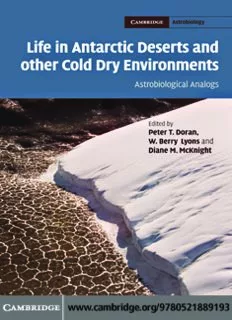
Life in Antarctic Deserts and other Cold Dry Environments: Astrobiological Analogs (Cambridge Astrobiology) PDF
Preview Life in Antarctic Deserts and other Cold Dry Environments: Astrobiological Analogs (Cambridge Astrobiology)
This page intentionally left blank LIFE IN ANTARCTIC DESERTS AND OTHER COLD DRY ENVIRONMENTS Astrobiological Analogs The McMurdo Dry Valleys form the largest relatively ice free area on the antarctic continent. The perennially ice covered lakes, ephemeral streams, and extensive areas of exposed soil are subject to low temperatures, limited precipitation, and salt accumulation. The dry valleys thus represent a region where life approaches its environmental limits. This unique ecosystem has been studied for several decades as an analog to environments on other planets, particularly Mars. For the first time, the detailed terrestrial research of thedryvalleysis broughttogetherhere,presentedfromanastrobiological perspective. Chapters include a discussion on the history of research in the valleys,ageologicalbackgroundofthevalleys,settingthemupasanalogsfor Mars, followed by chapters on the various subenvironments in the valleys suchaslakes,glaciers,andsoils.Includesconcludingchaptersonbiodiversity and other analog environments on Earth. Peter T. Doran is a Professor of Earth and Environmental Sciences and activeresearchscientistattheUniversityofIllinoisatChicago.Heisaveteran ofnumerousexpeditionstotheArcticandAntarcticinthepursuitofstudying climate and ecosystem change and astrobiology. Doran is currently the lead investigatorofNASA’sEnvironmentallyNon-DisturbingUnder-iceRobotic ANtarctiCExplorer(ENDURANCE).HeisonvariousNASAreviewpanels and working groups focused on future exploration of Mars and other locations of astrobiological interest and is a sitting member of the NASA SubcommitteeonPlanetaryProtection.Hehaspublishedmorethan50peer- reviewedscholarlyarticles.HeisamemberofAmericanGeophysicalUnion, the Union of Concerned Scientists, Committee on Space Research, the GeologicalSocietyofAmerica,andtheAmericanQuaternaryAssociation. W. Berry Lyons received his Ph.D. in chemical oceanography from the University of Connecticut in 1979. He has since carried out many research studiesintheAntarcticandrecentlysteppeddownastheleadinvestigatorof the McMurdo Dry Valleys Long Term Ecological Research (MCM LTER) project, one of the 26 LTER sites supported by the U.S. National Science Foundation. He is a U.S. representative on the Geosciences Scientific Group of the Scientific Committee for Antarctic Research (SCAR) and also serves as Treasurer for the International Association of GeoChemistry. He has coauthored over 200 scientific publications, many of them focused on antarctic and polar themes. He is currently a Professor in the School of Earth Sciences and former Director of the Byrd Polar Research Center at the Ohio State University. His primary research interests include aqueous geochemistry,environmentalgeochemistry,andtheimpactofclimatechange and anthropogenic activities on biogeochemical processes. Diane M. McKnight received her Ph.D. in Environmental Engineering from the Massachusetts Institute of Technology in 1979. She was a research hydrologistwiththeU.S.GeologicalSurveyinDenver,Colorado,from1979 to 1996, where she studied the biogeochemistry of aquatic ecosystems. She has been researching the Antarctic and Arctic since 1987, where she has conducted research on stream ecosystems as part of the McMurdo Dry Valleys Long Term Ecological Research (MCM LTER) project and alpine lakes as part of the Niwot Ridge Long Term Ecological Research (NWT LTER) project. Since 1996, she has been a Professor in the Department of Civil, Environmental and Architectural Engineering and a Fellow of the Institute of Arctic and Alpine Research at the University of Colorado, Boulder. She has coauthored over 180 scientific publications, many of them focused on polar and alpine themes. Her primary research interests include aquatic ecology of algae in lakes and streams, and biogeochemical studies of natural organic material and trace metals in freshwater systems. CambridgeAstrobiology SeriesEditors BruceJakosky,AlanBoss,FrancesWestall,DanielPrieurandCharlesCockell Booksintheseries 1. Planet Formation:Theory,Observations,and Experiments Edited by Hubert Klahr and Wolfgang Brandner ISBN 978-0-521-86015-4 2. Fitnessof theCosmos forLife: Biochemistry and Fine-Tuning Edited by John D. Barrow, Simon Conway Morris, Stephen J.Freeland and Charles L.Harper, Jr. ISBN 978-0-521-87102-0 3. PlanetarySystems and theOriginof Life EditedbyRalphPudritz,PaulHiggsandJonathanStone ISBN978-0-521-87548-6 4. Exploring theOrigin, Extent, and Future ofLife: Philosophical, Ethical and Theological Perspectives Edited by Constance M. Bertka ISBN 978-0-521-86363-6 LIFE IN ANTARCTIC DESERTS AND OTHER COLD DRY ENVIRONMENTS Astrobiological Analogs Edited by PETER T. DORAN UniversityofIllinoisatChicago W. BERRY LYONS OhioStateUniversity DIANE M. MCKNIGHT UniversityofColoradoatBoulder CAMBRIDGE UNIVERSITY PRESS Cambridge, New York, Melbourne, Madrid, Cape Town, Singapore, São Paulo, Delhi, Dubai, Tokyo Cambridge University Press The Edinburgh Building, Cambridge CB2 8RU, UK Published in the United States of America by Cambridge University Press, New York www.cambridge.org Information on this title: www.cambridge.org/9780521889193 © Cambridge University Press 2010 This publication is in copyright. Subject to statutory exception and to the provision of relevant collective licensing agreements, no reproduction of any part may take place without the written permission of Cambridge University Press. First published in print format 2010 ISBN-13 978-0-511-71307-1 eBook (NetLibrary) ISBN-13 978-0-521-88919-3 Hardback Cambridge University Press has no responsibility for the persistence or accuracy of urls for external or third-party internet websites referred to in this publication, and does not guarantee that any content on such websites is, or will remain, accurate or appropriate. Contents List of contributors page ix 1 Introduction 1 Peter T. Doran, W. Berry Lyons, and Diane M. McKnight 2 Geologic analogies between the surface of Mars and the McMurdo Dry Valleys: microclimate-related geomorphic features and evidence for climate change 9 David R. Marchant and James W. Head, III 3 The legacy of aqueous environments on soils of the McMurdo Dry Valleys: contexts for future exploration of martian soils 78 J. E. Barrett, Michael A. Poage, Michael N. Gooseff, and Cristina Takacs-Vesbach 4 The antarctic cryptoendolithic microbial ecosystem 110 Henry J. Sun, James A. Nienow, and Christopher P. McKay 5 Antarctic McMurdo Dry Valley stream ecosystems as analog to fluvial systems on Mars 139 Michael N. Gooseff, Diane M. McKnight, Michael H. Carr, and Jenny Baeseman 6 Saline lakes and ponds in the McMurdo Dry Valleys: ecological analogs to martian paleolake environments 160 Jill Mikucki, W. Berry Lyons, Ian Hawes, Brian D. Lanoil, and Peter T. Doran 7 The biogeochemistry and hydrology of McMurdo Dry Valley glaciers: is there life on martian ice now? 195 Martyn Tranter, Liz Bagshaw, Andrew G. Fountain, and Christine Foreman vii viii Contents 8 Factors promoting microbial diversity in the McMurdo Dry Valleys, Antarctica 221 Cristina Takacs-Vesbach, Lydia Zeglin, J. E. Barrett, Michael N. Gooseff, and John C. Priscu 9 Other analogs to Mars: high-altitude, subsurface, desert, and polar environments 258 Nathalie A. Cabrol, Dale T. Andersen, Carol R. Stoker, Pascal Lee, Christopher P. McKay, and David S. Wettergreen Index 306
Description: